It looks like you're using an Ad Blocker.
Please white-list or disable AboveTopSecret.com in your ad-blocking tool.
Thank you.
Some features of ATS will be disabled while you continue to use an ad-blocker.
share:
The Northern Mesopotamian tradition of showing the Abgal Priest holding a curious little handbag while tending the sacred tree tends to attract a
certain amount of curiousity, some consider it having something to do with ancient aliens as similar are seen in Meso-America, i want to put forward
an explanation here of what was the basis for their symbolic function, that they represent a Kursa, and once upon a time a clever little bee found
one;
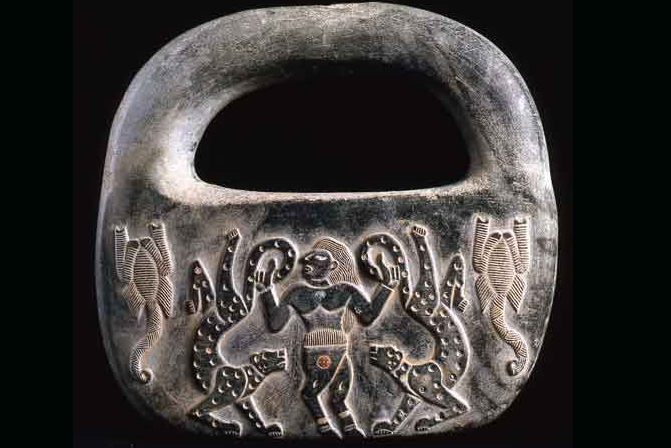
So what was a Kursa to the Hittites the above being from the myth of Telepinu, well it was a hunting bag in which to place your catches, there's a very good article here regarding the Kursa on page 137, they could be made of sheep hide or wicker work or beads, have metal handles or wooden, but they held such symbolic importance that they were Deified having their own Temple.
In discussing why this was so from the Hittite perspective i'll illustrate this with images from Jiroft curiously enough, as that culture silent in terms of translated text i consider as having the best recovered artifacts relating to this cult, suggesting an earlier common source to that of the Hittites, that being very ancient, indeed Kursa being seen at Gobekli Tepe.

Telepinu was the personification of the Divine child and represented harmonious balance, in his sulking absence nothing is quite right;
Then, it should be noted the analogous way in which chaos infiltrates into the divine body of Telepinu, he does not so much die as subsume himself into the wilderness;
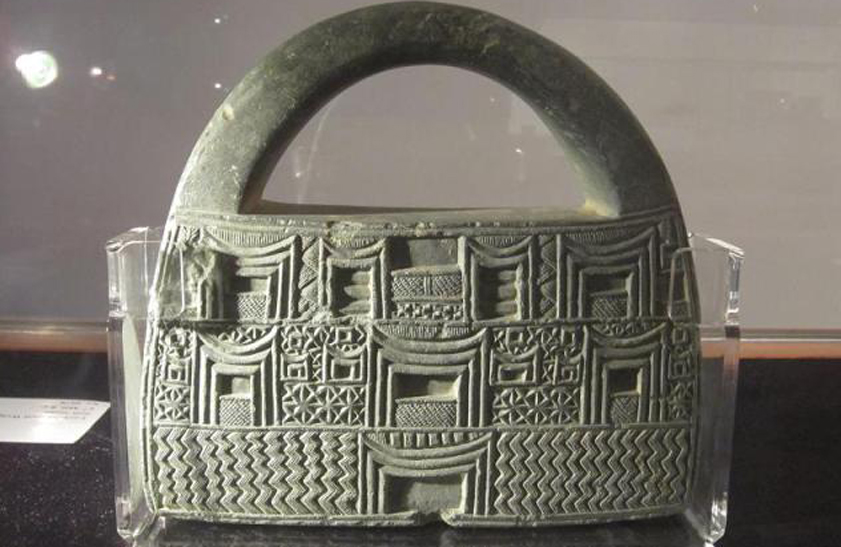
The body of Telepinu could be equated with that big house which constituted the entire cosmos, a house which falls into darkness and unease, and so the great Gods seek him out in order to facilitate his return, but cannot pass the threshold into his magical realm were he has taken himself, until the Mother Goddess sends the bee to seek him out.
At Lihzina was the Palace of the Sun Goddess of the Earth, the Mother of Telepinu, and there the bee found evidence for him in the form of the hunting bag, stinging him into activity and cleansing him with wax, it improved his mood with sweet offerings and prepared a path back to the civilized world.
We can see then that the symbolic hand bag would have had association with life, vigor and longevity and the general well being of the land, at Jiroft i think one sees all aspects of this mythos in the context of grave goods were the bag illustrates the relationship of a Telipinu type hero illustrating his relationship to nature, the connectivity between the Eastern and Western horizons in terms of constellations seen mirrored, and the cosmological palace of the great Palace and the windows of the horizon, an edifice of three layers generally.
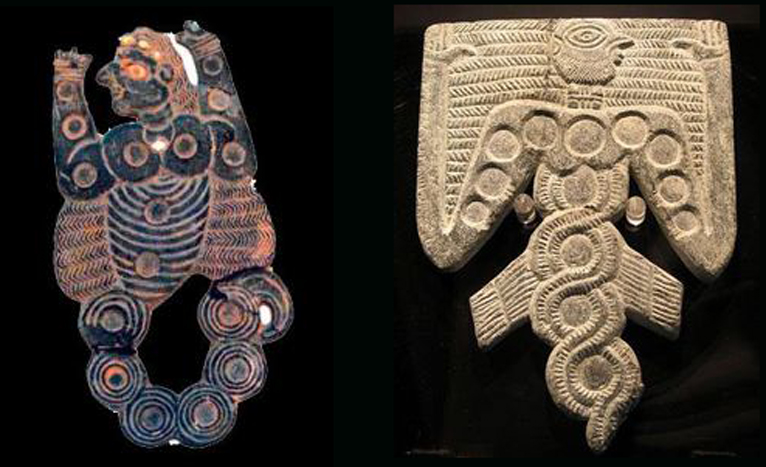
The aspect of the three springs in the Telepinu myth relates to connectivity with the underworld from which Telipinu essentially returns, underworld Goddesses such as Ishara and Allani related to sacred springs in terms of emergence.
It's interesting how the purification of Telepinu also relates to the cleansing of the big house, even in Egypt the Palace facade was an important aspect of early funerary ritual.
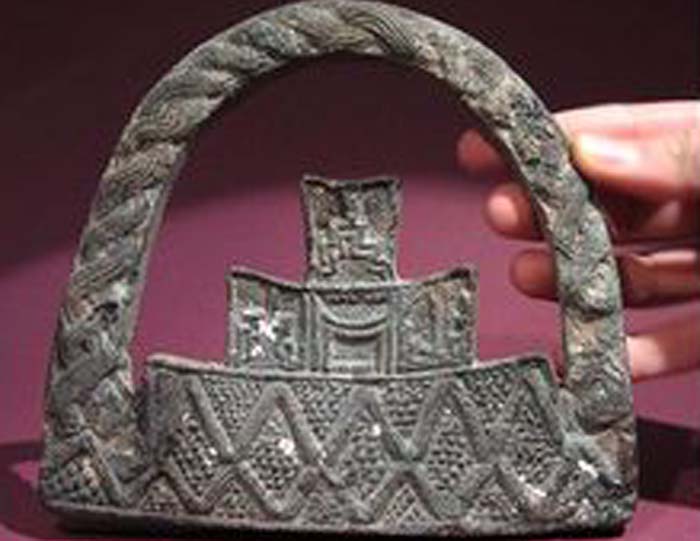
Theoretical perspective of the Telepinu myth
Anatolian fate Goddesses
When the bee finds the kursa, the bee brings it to Hanna-hanna. The Mother Goddess makes three springs; at one is an ippya-tree, at another a bowl, and at the last a fire is kindled. in this grove are three springs and an ippiya-tree.
The kursa is either hung upon an oak or is laid in the bowl. The time of need is ended with the return of the kursa

So what was a Kursa to the Hittites the above being from the myth of Telepinu, well it was a hunting bag in which to place your catches, there's a very good article here regarding the Kursa on page 137, they could be made of sheep hide or wicker work or beads, have metal handles or wooden, but they held such symbolic importance that they were Deified having their own Temple.
In discussing why this was so from the Hittite perspective i'll illustrate this with images from Jiroft curiously enough, as that culture silent in terms of translated text i consider as having the best recovered artifacts relating to this cult, suggesting an earlier common source to that of the Hittites, that being very ancient, indeed Kursa being seen at Gobekli Tepe.

it is not clear whether Telepinu was also the son of the Sun Goddess of the city of Arinna, or of Ḫannaḫanna, the mother of all Hittite gods—including the Storm God. Despite the potential ties with these goddesses and with the tutelary god of Ḫatti, Telepinu has not been easily placed in the Hittite pantheon, and this has led to very divergent hypotheses about his nature, as well as about his myth
Telepinu was the personification of the Divine child and represented harmonious balance, in his sulking absence nothing is quite right;
Then, it should be noted the analogous way in which chaos infiltrates into the divine body of Telepinu, he does not so much die as subsume himself into the wilderness;
Telepinu too went into the moor and blended with the moor. Over him the ḫalenzu-plant grew. Therefore barley and wheat no longer ripen. Cattle, sheep, and humans no longer become pregnant. And those already pregnant cannot give birth.
As societies equate in the “mythical discourse” the house with the body and the cosmos, the crisis mentioned in the myth seems to spread out towards the whole cosmos.

The body of Telepinu could be equated with that big house which constituted the entire cosmos, a house which falls into darkness and unease, and so the great Gods seek him out in order to facilitate his return, but cannot pass the threshold into his magical realm were he has taken himself, until the Mother Goddess sends the bee to seek him out.
You, O bee, should look for Telepinu. And when you find him, sting him on his hands and feet. Make him stand up. Take wax and wipe off his eyes and his hands. Purify him and bring him back to me.’”
...the bee searched the high mountains; it searched the deep valleys; it searched the Blue Deep. The honey was exhausted in its interior, But it found himin a meadow in the town of Liḫzina
“I have just sprinkled your paths, Telepinu, with sweet oil. Set out, Telepinu, on paths sprinkled with sweet oils.
At Lihzina was the Palace of the Sun Goddess of the Earth, the Mother of Telepinu, and there the bee found evidence for him in the form of the hunting bag, stinging him into activity and cleansing him with wax, it improved his mood with sweet offerings and prepared a path back to the civilized world.
Telepinu came back home to his house and took account of his land. The mist released the windows. The smoke released the house. The altars were in harmony again with the gods. The fireplace released the log. In the sheepfold he released the sheep. In the cattle barn he released the cattle. Then the mother looked after her child. The sheep looked after her lamb.
And Telepinu too look after the king and queen and took account of them in respect to life, vigor and longevity
We can see then that the symbolic hand bag would have had association with life, vigor and longevity and the general well being of the land, at Jiroft i think one sees all aspects of this mythos in the context of grave goods were the bag illustrates the relationship of a Telipinu type hero illustrating his relationship to nature, the connectivity between the Eastern and Western horizons in terms of constellations seen mirrored, and the cosmological palace of the great Palace and the windows of the horizon, an edifice of three layers generally.

When they took Heaven and Earth, the gods split up; the upper gods took Heaven, but the lower gods took Earth and the Netherworld. Everyone took its own. You, O river, took for yourself purification, life of progeny, and procreative power. Now, because someone says to someone else: it is terrible, then he goes back to you, O river, and to the Fate-goddesses and Mother-goddesses of the river bank, who create man
The aspect of the three springs in the Telepinu myth relates to connectivity with the underworld from which Telipinu essentially returns, underworld Goddesses such as Ishara and Allani related to sacred springs in terms of emergence.
The Stormgod of Nerik descends through his “beloved spring” to his mother in the underworld,and also the goddess of the underworld emerges from a spring to the upper world
It's interesting how the purification of Telepinu also relates to the cleansing of the big house, even in Egypt the Palace facade was an important aspect of early funerary ritual.
May Telepinu’s anger, wrath, sin, and sullenness depart. May the house release it. May the middle… release it. May the window release it. May the hinge release it. May the middle courtyard release it. May the city gate release it. May the gate complex release it. May it not go into the fruitful field, garden, or forest. May it go the route of the Sun Goddess (of the Dark Earth).

Theoretical perspective of the Telepinu myth
Anatolian fate Goddesses
edit on Kpm831229vAmerica/ChicagoWednesday1731 by Kantzveldt because: (no reason given)
a reply to: Kantzveldt
Kantzveldt, I have never been disappointed by one of your threads. This has been an interesting topic for me for quite awhile. So fascinating that this "handbag" is illustrated in so many different civilizations - found on artifacts from Sumeria, to Central America, it's just incredible to me.
Thank you for putting together another great thread, S & F my friend
Kantzveldt, I have never been disappointed by one of your threads. This has been an interesting topic for me for quite awhile. So fascinating that this "handbag" is illustrated in so many different civilizations - found on artifacts from Sumeria, to Central America, it's just incredible to me.
Thank you for putting together another great thread, S & F my friend
I think I'm going to have to put this down as a brain fart
There are numerous details of leather bags mentioned in Mesopotamian texts
they were a travelling lunchbox or used for sacred rites
etcsl.orinst.ox.ac.uk...
This is like Sitchin 101
There are numerous details of leather bags mentioned in Mesopotamian texts
they were a travelling lunchbox or used for sacred rites
etcsl.orinst.ox.ac.uk...
This is like Sitchin 101
edit on 17-8-2016 by Marduk because: (no reason given)
The same kind of bags appear on one of the pillars at Gobekli Tepe AND in one of the first known depictions of Quetzalcoatl. I tried to copy from the
e-book, Graham Hancock's Magicians of the Gods but it
wouldn't let me. Probably DRM in the way. Anyway, Gobekli Tepe in Turkey is probably the oldest known settlement. The depictions look very much like
those in OP's post.
edit on 8/17/2016 by schuyler because: (no reason given)
a reply to: Marduk
You need to read the article i linked to on the Kursa here to realize the importance of a particular bag in an important context, the finding of which related to the restoration of the land, of course they had bags for many purposes but the context for the Kursa was that of the hunter, in association with the bow, arrows and quiver, the closest example in those you linked to,
a reply to: FamCore
It's a question of how old the tradition was, it had certainly developed to take into account pastoralist tradition and civilization but in essence it had all the trappings of hunting and gathering.
a reply to: schuyler
Yes these bags and you can see little animals associated with them looking closely...
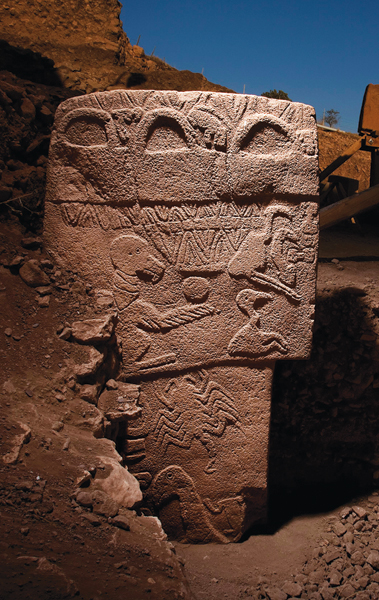
You need to read the article i linked to on the Kursa here to realize the importance of a particular bag in an important context, the finding of which related to the restoration of the land, of course they had bags for many purposes but the context for the Kursa was that of the hunter, in association with the bow, arrows and quiver, the closest example in those you linked to,
To Nergal, the Enlil of the nether world, in his palace, the shepherd Ur-Namma offered a mace, a large bow with quiver and arrows, an artfully made barbed dagger, and a multicoloured leather bag for wearing at the hip.
a reply to: FamCore
It's a question of how old the tradition was, it had certainly developed to take into account pastoralist tradition and civilization but in essence it had all the trappings of hunting and gathering.
a reply to: schuyler
Yes these bags and you can see little animals associated with them looking closely...

edit on Kpm831229vAmerica/ChicagoWednesday1731 by Kantzveldt because: (no reason given)
edit on
Kpm831229vAmerica/ChicagoWednesday1731 by Kantzveldt because: (no reason given)
a reply to: Kantzveldt
err ok, so I need to read your recent interpretation rather than what has already been established based on textual evidence. Of which I have already provided you with copious amounts of refutation
Yeah I'll pass, please continue with your unevidenced nonsense
err ok, so I need to read your recent interpretation rather than what has already been established based on textual evidence. Of which I have already provided you with copious amounts of refutation
Yeah I'll pass, please continue with your unevidenced nonsense
In Neo-Assyrian art, objects resembling a pine
cone and a bucket (or occasionally a bucket
alone) are held as attributes by a number of
different genies, often in association with the
stylised tree; the 'cone' is held up in the right
hand, the bucket held down in the left. Only
very rarely are these objects held by figures
which might be interpreted as entirely human;
almost always they are held by genies or
human-animal hybrids (see demons and
monsters). As well as in front of the stylised
tree, the bucket and cone are seen held before
floral decorative elements, guardian supernatural
figures, the king or his attendants, or
open doorways. The cone has been interpreted
as a fir cone (Pinus brutia), as the male flower of
the date palm or as a clay object in imitation of
such. The bucket has been thought to have
been of metal or wicker, and to have contained
either water or pollen (see stylised tree and its
`rituals'). Written sources on the matter are
few, but it seems clear that the bucket and cone
were associated with purification, for they are
known respectively as banduddû (bucket) and,
significantly, mullitu (purifier), and figurines 11
of genies holding these attributes were among
the types placed within buildings for protection
from malevolent demons and disease (see
building rites and deposits; magic and
sorcery).
a reply to: Marduk
I'm suggesting you read an article by an expert on Hittite culture to understand the important ritual context of the hunting bag which was Deified in it's own right, why it had association with harmonious life, vigor and longevity and the general well being of the land, which would be an appropriate symbolic function for those later seen in Northern Mesopotamia, the fact that they obviously also had general purpose leather pouches and bags is neither here nor there, your feeling the need to point that out was pathetic...no point trying to make out it was a wicker bucket either that's even sillier.
I'm suggesting you read an article by an expert on Hittite culture to understand the important ritual context of the hunting bag which was Deified in it's own right, why it had association with harmonious life, vigor and longevity and the general well being of the land, which would be an appropriate symbolic function for those later seen in Northern Mesopotamia, the fact that they obviously also had general purpose leather pouches and bags is neither here nor there, your feeling the need to point that out was pathetic...no point trying to make out it was a wicker bucket either that's even sillier.
edit on Kpm831229vAmerica/ChicagoWednesday1731 by Kantzveldt because: (no reason given)
(post by Marduk removed for a manners violation)
a reply to: Marduk
You can do what you want, but it's hardly simply a Sumerian concern when seemingly everyone from Jiroft was buried with a similar looking object to those seen in Northern Mesopotamia, which are generally Assyrian anyway and thus post-dating the Hittites, there also being considerable Hurrian and Mitanni input into the traditional representations of that period.
Also just because the thread relates to handbags doesn't mean you should try hitting me with yours...
You can do what you want, but it's hardly simply a Sumerian concern when seemingly everyone from Jiroft was buried with a similar looking object to those seen in Northern Mesopotamia, which are generally Assyrian anyway and thus post-dating the Hittites, there also being considerable Hurrian and Mitanni input into the traditional representations of that period.
Also just because the thread relates to handbags doesn't mean you should try hitting me with yours...
edit on Kpm831229vAmerica/ChicagoWednesday1731 by Kantzveldt because: (no reason given)
originally posted by: Kantzveldt
a reply to: Marduk
You can do what you want, but it's hardly simply a Sumerian concern when seemingly everyone from Jiroft was buried with a similar looking object to those seen in Northern Mesopotamia, which are generally Assyrian anyway and thus post-dating the Hittites, there also being considerable Hurrian and Mitanni input into the traditional representations of that period.
Jiroft is hundreds of years too late to be meaningful, as are the Mitanni and Hurrians
wow you're really trying to hold on to your delusion with both hands aren't you...
I already posted you the catalogue reference for ETCSL, and the page on buckets from Jeremy Blacks, "gods demons and symbols of ancient Mesopotamia" if you want to pretend that information didn't happen, that's cool
SNIP
edit on 17-8-2016 by Marduk because: (no reason given)
edit on Wed Aug 17 2016 by Jbird because: (no reason
given)
a reply to: Marduk
Alright i simply hadn't realized that the 3rd millenium culture of Jiroft was simply hundreds of years too late to be meaningful..., now i can understand why you simply refuse to read anything regarding the Hittites and insist upon the exclusivity of Assyrian representation, i should just go read Jeremy Black and seek forgivness...to be honest though i'm starting to realize why Telepinu thought sod it.
Alright i simply hadn't realized that the 3rd millenium culture of Jiroft was simply hundreds of years too late to be meaningful..., now i can understand why you simply refuse to read anything regarding the Hittites and insist upon the exclusivity of Assyrian representation, i should just go read Jeremy Black and seek forgivness...to be honest though i'm starting to realize why Telepinu thought sod it.
edit on Kpm831229vAmerica/ChicagoWednesday1731 by Kantzveldt because: (no reason given)
originally posted by: Kantzveldt
a reply to: Marduk
Alright i simply hadn't realized that the 3rd millenium culture of Jiroft was simply hundreds of years too late to be meaningful..., now i can understand why you simply refuse to read anything regarding the Hittites and insist upon the exclusivity of Assyrian representation, i should just go read Jeremy Black and seek forgivness...to be honest though i'm starting to realize why Telepinu thought sod it.
Jiroft's heyday was from 2500 B.C. to 2200 B.C
Modern historians have suggested that Sumer was first permanently settled between c. 5500 and 4000 BC by a West Asian people who spoke the Sumerian language
do the math...
a reply to: Kantzveldt
Hmm , what did their Masters the Nephilim Hunt ? Certain Human Genomes ?
Hmm , what did their Masters the Nephilim Hunt ? Certain Human Genomes ?
edit on 17-8-2016 by Zanti Misfit because: spelling
a reply to: Marduk
The reason i didn't even mention the Sumerians in the OP was that even though the Abgal priesthood had been a Sumerian institution there is no evidence for such iconography in their culture, i referred only to the later Northern Mesopotamian representations, these were first introduced by the Kassites who were;
Thus the iconography was introduced by people from the same general region as Jiroft meaning they were not so meaningless, also of note it was the Hittites that actually defeated Babylon and handed it over to their allies the Kassites, there may be a case for their introducing the mythos into Hittite culture.
The reason i didn't even mention the Sumerians in the OP was that even though the Abgal priesthood had been a Sumerian institution there is no evidence for such iconography in their culture, i referred only to the later Northern Mesopotamian representations, these were first introduced by the Kassites who were;
The original homeland of the Kassites is not well known, but appears to have been located in the Zagros Mountains in what is now the Lorestan Province of Iran.
Thus the iconography was introduced by people from the same general region as Jiroft meaning they were not so meaningless, also of note it was the Hittites that actually defeated Babylon and handed it over to their allies the Kassites, there may be a case for their introducing the mythos into Hittite culture.
edit on Kpm831229vAmerica/ChicagoWednesday1731 by Kantzveldt because: (no reason given)
a reply to: Kantzveldt
I've read the chapter on Hittite Kursa "hunting Bag" and now I'm on A theoretical perspective... Interesting footnote 9
As far as I've ever been told, Anatolia is the bridge between East and West and even, to a lesser degree, Mesopotamia and the Levant.
I haven't read all the linked material, but from what I gather so far; Telepinu would be something like tutelary deity of city or state or civilization itself. Absenting himself from the ordered cosmos (state civilization) resulted in disorder for the domestic(civilized) animals and people and gods, not a general disorder effecting even the area outside of civilized control. His escape is not to the underworld but to the wild, untamed, uncivilized. That would be a middle ground between daylight and night-time underworld.
Hunting bag may be a symbol of the buffer zone between order and chaos, civilized and primitive.
I've read the chapter on Hittite Kursa "hunting Bag" and now I'm on A theoretical perspective... Interesting footnote 9
9 However, to Durand it seems that different societies focus their imagination on one of these two regimes:
modern “Western” societies tend to represent reality according to the family of “daytime regime” symbols,
whereas “mythical discourse” societies do so according to the “night-time regime.”
Durand 2000: 98, 104-110; Durand 2004: 372; Franzone 2005: 121-131.
As far as I've ever been told, Anatolia is the bridge between East and West and even, to a lesser degree, Mesopotamia and the Levant.
I haven't read all the linked material, but from what I gather so far; Telepinu would be something like tutelary deity of city or state or civilization itself. Absenting himself from the ordered cosmos (state civilization) resulted in disorder for the domestic(civilized) animals and people and gods, not a general disorder effecting even the area outside of civilized control. His escape is not to the underworld but to the wild, untamed, uncivilized. That would be a middle ground between daylight and night-time underworld.
Hunting bag may be a symbol of the buffer zone between order and chaos, civilized and primitive.
edit on 17-8-2016 by pthena because: (no reason given)
House in a bag....house boat....litle animals .....Noahs Ark?
a reply to: pthena
It's a very good analysis because one see's the connection between the re-planting of a tree of life with reyards to the return of Telepinu, and thus the relationship of the Kursa to that in such iconography;
I think the bag also would relate in some sense to that which is retained, in relationship to deep sleep and probably even death, that what the bee discovers is that which Telepinu had previously accomplished, and his bag is returned to him.
It's a very good analysis because one see's the connection between the re-planting of a tree of life with reyards to the return of Telepinu, and thus the relationship of the Kursa to that in such iconography;
Further supporting the hypothesis that this myth assures the future wellbeing previously not granted by this god, there is a very meaningful mention of the planting of a tree. The TMI reads: “Before Telepinu stands an eyan-tree (or pole). From the eyan is suspended a hunting bag (made from the skin) of a sheep. In (the bag) lies Sheep Fat. In it lie (symbols of) Animal Fecundity and Win. In it lie (symbols of) Cattle and Sheep. In it lie Longevity and Progeny.
Durand’s analysis of the symbolism of trees (originally associated with fire, the sacrificial element par excellence providing total destruction and rebirth), reveals how they are associated to the idea of transcendence, of death followed by resurrection. In this sense, as Durand suggested, the tree conjures up the drama of death followed by resurrection. Furthermore, Durand’s description of the meaning of trees is in accordance with the ideas of eternity, continuity, well-being, and prosperity the Hittites ascribed to this tree—an oak, fir or perhaps fruit tree
I think the bag also would relate in some sense to that which is retained, in relationship to deep sleep and probably even death, that what the bee discovers is that which Telepinu had previously accomplished, and his bag is returned to him.
a reply to: Kantzveldt
I don't know what kind of trees may grow in Anatolia, but where I grew up, there's a type of live oak that sterilizes the ground around the trunk, about 15 foot radius. Within that area, no shrubs or vines grow. That would be a fairly decent symbol for a natural ordered cosmos.
Ritually actualizing the myth: Here's a song, with built in repetition (repeating cycle) "Here I go again" combined with "the only road I know", as either the road to the wild, or even the road marked by the bee, and "'cos I know what it means to walk along the lonely street of dreams."
I don't know what kind of trees may grow in Anatolia, but where I grew up, there's a type of live oak that sterilizes the ground around the trunk, about 15 foot radius. Within that area, no shrubs or vines grow. That would be a fairly decent symbol for a natural ordered cosmos.
Thus, forced to leave a space symbolically linked to the idea of a telluric uterus, the god is led by the persistent action of gods and men to grant eternal life to the cosmos, along with all his virtues. In fact, this myth not only narrated how the gods originally restored order in the sacred places—and, consequently, how men could do so in chaotic situations by ritually actualizing this myth—but also the rebirth of the god. Furthermore, it brought the previous chaos to an end, a fact linked to the new mode of existence of the god. I refer specifically to the god’s ability to give eternal life and permanent well-being to the Hittite kingdom.
In order that the Hittite world acquires these qualities, the myth presents a large number of images alluding to a new beginning, such as the embryonic situations of Telepinu. Among these images, sleep is especially important, for even if Telepinu is not a god who dies, the presence of sleep, so closely bound to the symbolism of death, lead us to think that after the “chaotic stage” a new situation began for the god, as for the whole cosmos.
Ritually actualizing the myth: Here's a song, with built in repetition (repeating cycle) "Here I go again" combined with "the only road I know", as either the road to the wild, or even the road marked by the bee, and "'cos I know what it means to walk along the lonely street of dreams."
a reply to: pthena
There were various trees to represent various things, in terms of the Pine cone and the Cedar that represented the connectivity to the Heavens, it was also the case that the Mountain of the horizon often was styled after a Pine Cone, and it's usage as a symbol indicated that this connectivity needed sometimes to be regenerated, pine cones making for far better seeds than sprinklers, both the bag and the cone being containers.
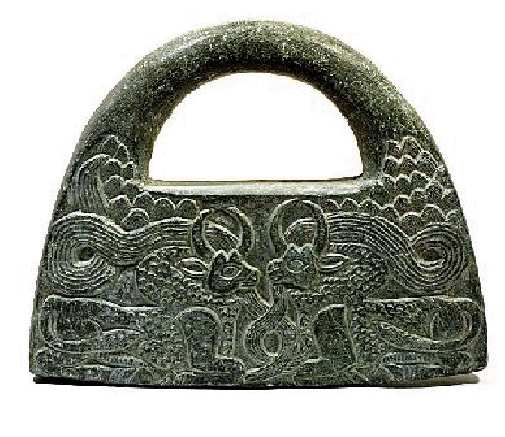
I thought it interesting how this myth could help illustrate many if not all the things we have been recently discussing, that the path back is also the path forward, that without regeneration there will only ever be harsh words and the descent into chaos, and it's important to recognize the continuity in this tradition from the hunter gatherer to the pastoralist to the urbanite, that it needs to be taken forward.
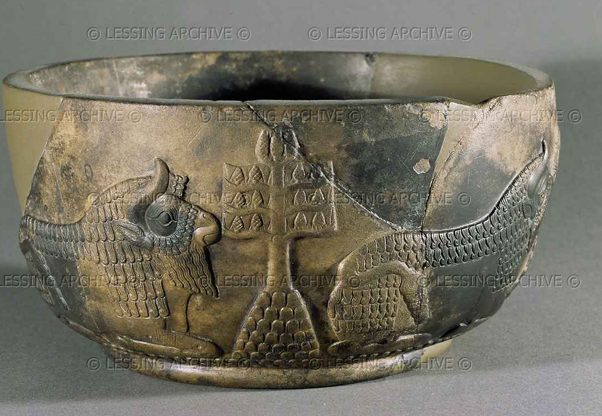
It's also a tradition that requires connectivity between all levels of the Cosmos, connectivity across the horizon between life and death, connectivity between the Feminine and Masculine archetypes, also requiring magical little bees to help establish those connections and suggest ways forward, but they seem to have considered this as something of a game with regards to the hybrid figure relating to Scorpio as the source...
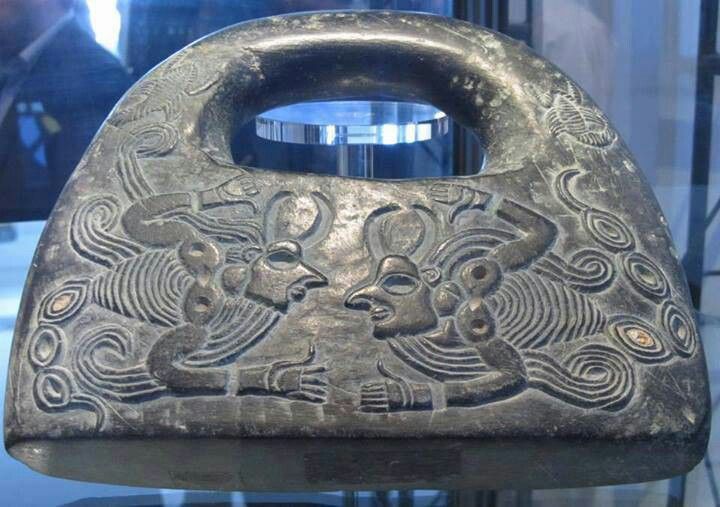
There were various trees to represent various things, in terms of the Pine cone and the Cedar that represented the connectivity to the Heavens, it was also the case that the Mountain of the horizon often was styled after a Pine Cone, and it's usage as a symbol indicated that this connectivity needed sometimes to be regenerated, pine cones making for far better seeds than sprinklers, both the bag and the cone being containers.

I thought it interesting how this myth could help illustrate many if not all the things we have been recently discussing, that the path back is also the path forward, that without regeneration there will only ever be harsh words and the descent into chaos, and it's important to recognize the continuity in this tradition from the hunter gatherer to the pastoralist to the urbanite, that it needs to be taken forward.

It's also a tradition that requires connectivity between all levels of the Cosmos, connectivity across the horizon between life and death, connectivity between the Feminine and Masculine archetypes, also requiring magical little bees to help establish those connections and suggest ways forward, but they seem to have considered this as something of a game with regards to the hybrid figure relating to Scorpio as the source...

edit on Kam831230vAmerica/ChicagoThursday1831 by Kantzveldt because: (no reason given)
edit on
Kam831230vAmerica/ChicagoThursday1831 by Kantzveldt because: (no reason given)
new topics
-
1 Billion dollars
General Entertainment: 5 hours ago -
London Christmas Market BANS Word ‘Christmas’
Social Issues and Civil Unrest: 6 hours ago -
Marvin Gabrion's sentence commuted by Biden
US Political Madness: 7 hours ago -
Parker Solar Probe is about to Kiss the Sun
Space Exploration: 8 hours ago -
Drones On Live Beach Cam New Jersey.
Aliens and UFOs: 10 hours ago -
Christmas Dinner ??
Food and Cooking: 10 hours ago
top topics
-
Merry Christmas !!
General Chit Chat: 13 hours ago, 14 flags -
Marvin Gabrion's sentence commuted by Biden
US Political Madness: 7 hours ago, 14 flags -
London Christmas Market BANS Word ‘Christmas’
Social Issues and Civil Unrest: 6 hours ago, 11 flags -
Christmas Dinner ??
Food and Cooking: 10 hours ago, 6 flags -
Drones On Live Beach Cam New Jersey.
Aliens and UFOs: 10 hours ago, 4 flags -
Parker Solar Probe is about to Kiss the Sun
Space Exploration: 8 hours ago, 4 flags -
1 Billion dollars
General Entertainment: 5 hours ago, 4 flags
active topics
-
1 Billion dollars
General Entertainment • 6 • : Flyingclaydisk -
NYPD arrests migrant who allegedly set woman on fire on subway train, watched her burn to death
Breaking Alternative News • 44 • : Flyingclaydisk -
Marvin Gabrion's sentence commuted by Biden
US Political Madness • 7 • : Naftalin -
-@TH3WH17ERABB17- -Q- ---TIME TO SHOW THE WORLD--- -Part- --44--
Dissecting Disinformation • 3803 • : MetalThunder -
London Christmas Market BANS Word ‘Christmas’
Social Issues and Civil Unrest • 29 • : Naftalin -
Merry Christmas !!
General Chit Chat • 14 • : KrustyKrab -
Can someone 'splain me like I'm 5. Blockchain?
Science & Technology • 95 • : cherokeetroy -
F-18 shot down over Red Sea....by our own Destroyer?
Other Current Events • 19 • : matafuchs -
Parker Solar Probe is about to Kiss the Sun
Space Exploration • 7 • : Flyingclaydisk -
Christmas Dinner ??
Food and Cooking • 12 • : Naftalin
